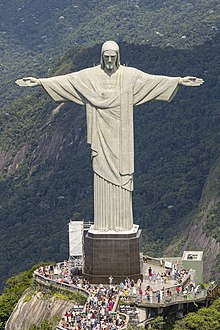Cristo Redentor | |
 The statue in 2022 | |
 | |
| 22°57′7″S 43°12′38″W / 22.95194°S 43.21056°W | |
| Location | Corcovado mountain, Rio de Janeiro, Brazil |
|---|---|
| Designer | Designed by sculptors Paul Landowski and Heitor da Silva Costa and built by engineer Heitor da Silva Costa in collaboration with Albert Caquot. Sculptor Gheorghe Leonida created the face |
| Material | Reinforced concrete with soapstone veneer |
| Width | 28 metres (92 ft) |
| Height | 30 metres (98 ft), 38 metres (125 ft) with its pedestal |
| Completion date | Dedicated October 13, 1931 |
| Consecrated October 12, 2006 New Seven Wonders of the World July 7, 2007 | |
| Designated | 2001 |
| Reference no. | 1478 |
Christ the Redeemer (Portuguese: Cristo Redentor, standard Brazilian Portuguese: [ˈkɾistu ʁedẽˈtoʁ]) is an Art Deco statue of Jesus in Rio de Janeiro, Brazil, created by French-Polish sculptor Paul Landowski and built by Brazilian engineer Heitor da Silva Costa, in collaboration with French engineer Albert Caquot. Romanian sculptor Gheorghe Leonida sculpted the face. Constructed between 1922 and 1931, the statue is 30 metres (98 ft) high, excluding its 8-metre (26 ft) pedestal. The arms stretch 28 metres (92 ft) wide.[1][2] It is made of reinforced concrete and soapstone.[3][4][5] Christ the Redeemer differs considerably from its original design, as the initial plan was a large Christ with a globe in one hand and a cross in the other. Although the project organizers originally accepted the design, it later changed to the statue of today, with the arms spread out wide.
The statue weighs 635 metric tons (625 long, 700 short tons), and is located at the peak of the 700-metre (2,300 ft) Corcovado mountain in the Tijuca National Park overlooking the city of Rio de Janeiro. This statue is the largest Art Deco–style sculpture in the world.[6] A symbol of Christianity around the world, the statue has also become a cultural icon of both Rio de Janeiro and Brazil and was voted one of the New 7 Wonders of the World.[7]
- ^ Murray, Lorraine. "Christ the Redeemer (last updated 13 January 2014)". Encyclopædia Britannica. Retrieved July 11, 2014.
- ^ Giumbelli, Emerson (2014). Símbolos Religiosos em Controvérsia (in Portuguese). São Paulo: Terceiro Nome. 244. ISBN 978-85-7816-137-8.
- ^ "Christ the Redeemer". Time. October 26, 1931. Archived from the original on September 30, 2007. Retrieved July 11, 2007.
- ^ "Brazil: Crocovado mountain – Statue of Christ". Travel Channel. Archived from the original on May 16, 2007. Retrieved July 7, 2007.
- ^ "Sanctuary Status for Rio landmark". BBC News. October 13, 2006. Retrieved July 7, 2007.
- ^ Asare, Daniel (September 14, 2023). "Christ the Redeemer". Encyclopædia Britannica. Retrieved September 15, 2023.
- ^ "The New Seven Wonders of the World". Hindustan Times. July 8, 2007. Archived from the original on September 30, 2007. Retrieved July 11, 2007.